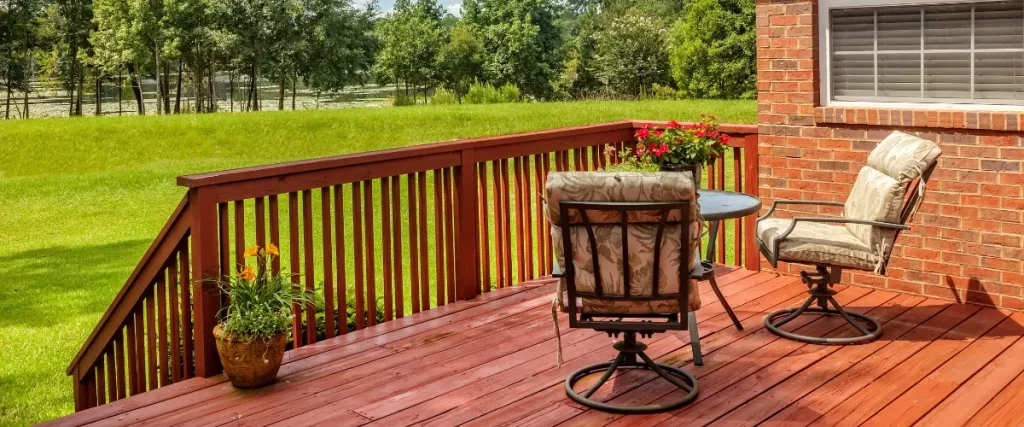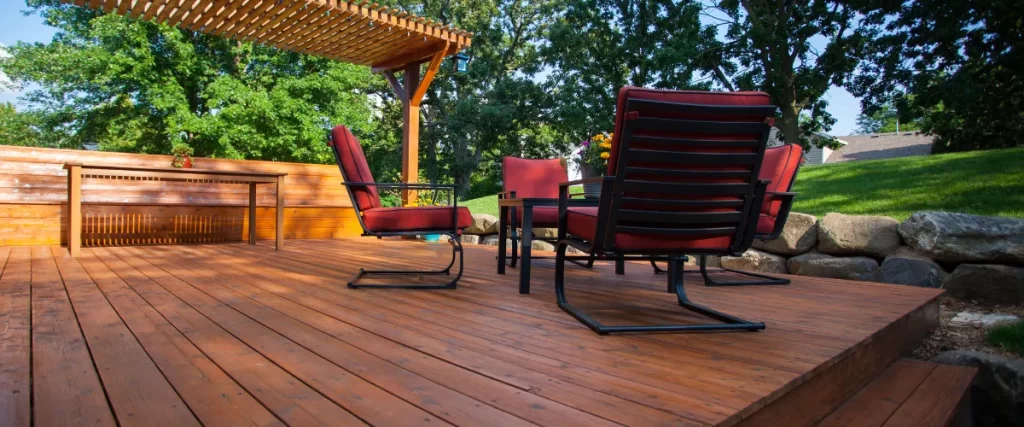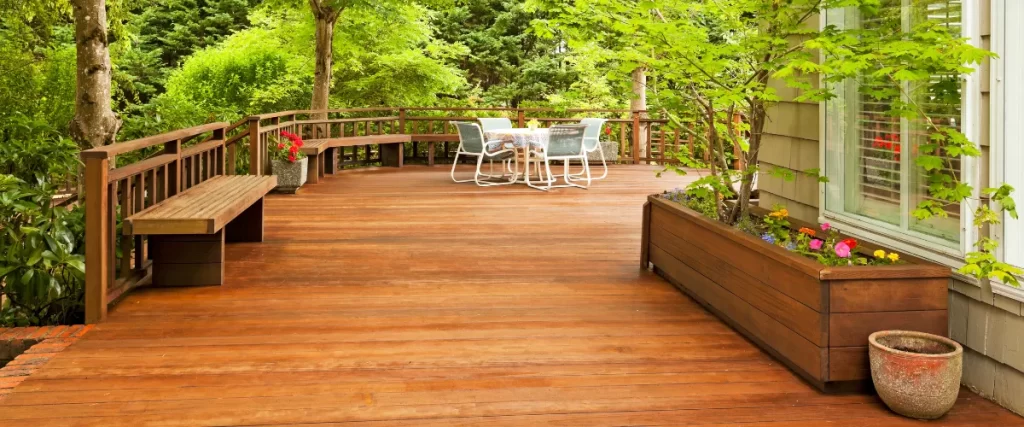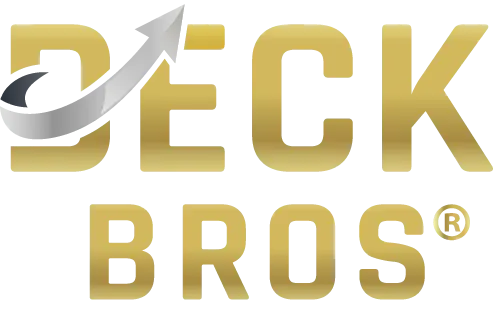A worn-out deck doesn’t mean it’s time to start over. Resurfacing your old deck is a cost-effective way to restore its beauty and extend its life. With a little effort and the right materials, your deck can go from weathered to wonderful without the need for a full replacement.
Let’s walk through everything you need to know about deck resurfacing, so you can decide if it’s the right move for your home.

What Is Deck Resurfacing?
Deck resurfacing is the process of updating the surface of your existing deck while keeping its original structure intact. Instead of tearing everything down, you replace the old, worn-out boards with new decking materials. It’s a great option if the frame of your deck is still in good condition.
This method saves time, money, and materials, making it an eco-friendly and budget-friendly choice. Plus, it allows you to customize your deck with new materials, colors, and features for a fresh, updated look.
When Should You Consider Resurfacing Your Deck?
Not all decks are candidates for resurfacing, but if your deck has the following characteristics, it might be a good fit:
- Sturdy Frame: The underlying structure must be solid and free from rot or major damage.
- Worn Boards: The surface boards are cracked, splintered, or faded, but the frame underneath is intact.
- No Major Shifting: If the deck hasn’t shifted or settled unevenly, resurfacing is a viable option.
- Budget Constraints: Resurfacing costs significantly less than building a new deck, making it a smart option for saving money.
Materials for Deck Resurfacing
One of the exciting parts of resurfacing is choosing the materials. Here are some popular options to consider:
1. Pressure-Treated Wood
A classic choice, pressure-treated wood is durable, affordable, and readily available. It’s treated to resist rot and insect damage, making it ideal for outdoor use. However, it requires regular staining or sealing to maintain its appearance.
2. Composite Decking
Composite decking is a low-maintenance and long-lasting option made from a mix of wood fibers and plastic. It comes in a variety of colors and finishes, giving you a modern and polished look. It’s also resistant to splintering, warping, and fading.
3. Hardwoods
Hardwoods like cedar and redwood are natural and beautiful. They’re resistant to decay and pests, but they require regular maintenance to preserve their color and prevent cracking.
4. PVC Decking
For a sleek, modern look, PVC decking is a great choice. It’s 100% synthetic, so it won’t rot, warp, or splinter. Plus, it’s incredibly low-maintenance and easy to clean.
Steps to Resurface an Old Deck
Resurfacing your deck might sound complicated, but it’s straightforward with a little planning. Here’s a simple step-by-step guide:
Step 1: Inspect the Deck
Before anything else, inspect your deck thoroughly. Check the frame for rot, structural issues, or loose connections. If you find any damage, it will need to be repaired or replaced before resurfacing.
Step 2: Remove Old Boards
Carefully remove the old decking boards, nails, or screws. A pry bar and drill will come in handy here. Dispose of the old materials responsibly.
Step 3: Clean and Prep the Frame
Once the boards are removed, clean the frame thoroughly. Use a pressure washer to remove dirt and grime, and check for any hidden damage. Sand any rough edges to ensure a smooth finish.
Step 4: Choose and Install New Decking
Select the new decking material that best suits your needs and style. Install the boards according to the manufacturer’s instructions, ensuring everything is aligned and securely fastened.
Step 5: Add Finishing Touches
Complete the project by adding finishing touches like railings, stairs, or built-in seating. Don’t forget to seal or stain the deck if needed to protect it from the elements.
Benefits of Resurfacing Your Deck
Resurfacing offers several advantages that make it a smart choice for homeowners:
- Cost Savings: It’s much cheaper than building a new deck from scratch.
- Eco-Friendly: Reusing the frame reduces waste and environmental impact.
- Customizable: You can choose modern materials and designs to match your home’s style.
- Quick Turnaround: Resurfacing takes less time than constructing a new deck, so you can enjoy your outdoor space sooner.
- Improved Safety: New boards and finishes eliminate hazards like splinters and loose planks.
Cost of Deck Resurfacing
The cost of resurfacing depends on the size of your deck and the materials you choose. Here are some average costs to help you budget:
- Pressure-Treated Wood: $5–$7 per square foot
- Composite Decking: $12–$15 per square foot
- Hardwoods: $8–$12 per square foot
- PVC Decking: $15–$20 per square foot
Additional costs may include hardware, stains, and professional labor if you’re not doing it yourself.

Add-On Features to Consider During Resurfacing
When resurfacing your deck, it’s the perfect time to think about adding extra features that enhance its functionality and aesthetic appeal. Here are some popular options to consider:
Built-In Lighting
Incorporate lighting into your deck design for both ambiance and safety. Options like recessed lights, post cap lights, or string lights can transform your deck into a cozy evening retreat while ensuring visibility during nighttime gatherings.
Railings and Balusters
If your deck doesn’t already have railings or if your current ones are outdated, upgrading to modern options can make a big difference. Glass, metal, or composite railings add style while providing safety, especially for elevated decks.
Pergolas or Shade Structures
Adding a pergola or other shade structure can provide relief on hot summer days. These features not only make your deck more comfortable but also add architectural interest, creating a focal point for your outdoor space.
Planter Boxes
Integrated planter boxes are a great way to bring greenery and life to your deck. They can serve as natural dividers, add color, or even allow you to grow herbs and small plants for a functional touch.
Built-In Seating
Instead of relying on portable furniture, built-in benches offer a sleek, space-saving seating option. They’re particularly useful for small decks and provide a clean, cohesive look.
Outdoor Kitchens
If you’re a fan of outdoor entertaining, consider adding features like a built-in grill, prep station, or even a small outdoor fridge. While it’s a more significant investment, it can make your deck the ultimate hosting spot.
These upgrades can elevate your deck from a basic outdoor space to a multifunctional haven that’s perfect for relaxing, entertaining, and enjoying the outdoors.
Common Mistakes to Avoid
Resurfacing a deck can be a smooth process, but there are a few pitfalls to watch out for:
- Ignoring the Frame: Always check the frame for damage before starting. Skipping this step can lead to costly repairs later.
- Choosing the Wrong Material: Consider your climate and lifestyle when selecting materials. For example, composites work well in wet areas, while hardwoods shine in dry climates.
- Not Sealing the Deck: If using wood, make sure to apply a sealant to protect it from water damage and UV rays.
- Improper Fastening: Use the right screws or fasteners to ensure a secure and long-lasting deck.
FAQ
How long does resurfacing take?
It usually takes 2–4 days, depending on the size of the deck and the materials used.
Can I resurface my deck myself?
Yes! With the right tools and some patience, resurfacing can be a manageable DIY project.
Is resurfacing cheaper than building a new deck?
Absolutely. Resurfacing costs a fraction of what it takes to construct a new deck.
What if my deck frame is damaged?
If the frame is damaged, it will need to be repaired or replaced before resurfacing.
How often should I resurface my deck?
This depends on the material, but most decks benefit from resurfacing every 10–15 years.

Give Your Deck a Fresh Start with Deck Bros
Resurfacing your old deck is the perfect way to breathe new life into your outdoor space without breaking the bank. Whether you’re replacing weathered boards or upgrading to a sleek new material, you’ll love the transformation.
At Deck Bros, we’re here to make the process easy and stress-free. With expert craftsmanship, high-quality materials, and unbeatable customer service, we’ll help you create a deck that looks brand new. Contact Deck Bros today for a free consultation at (402) 369-5724, and let’s kickstart your deck building project!
